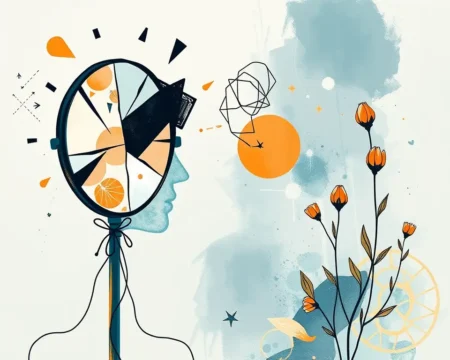Navigating the teenage years can feel like riding a rollercoaster blindfolded. Academic stress, social pressures, and figuring out who you are can take a toll on your mental well-being. The good news is that taking care of your mental health doesn’t have to be a chore. It can be fun, engaging, and incredibly empowering. Here are 25 activities to boost your mood, manage stress, and build a stronger, happier you.
Understanding Teen Mental Health
Teenagers face a unique set of challenges that can impact their mental health. According to the Center for Children and Youth (CCY), common issues include anxiety, depression, and stress, often triggered by academic pressures, social dynamics, and rapid changes. Mental health plays a crucial role in a teen’s overall well-being, directly impacting their daily lives.
The Importance of Mental Health Activities
Engaging in mental health activities offers a range of benefits. These activities provide constructive outlets to express emotions, develop coping skills, and connect with peers. Through these activities, teens can better understand their feelings, reduce anxiety, and build confidence as they face life’s challenges.
Mindful Moments: Activities for Stress Reduction and Emotional Regulation
1. Mindfulness Meditation
Mindfulness is about being present in the moment, without judgment. It involves focusing on your surroundings, thoughts, and feelings. Meditation introduces teenagers to mindfulness, which involves focusing their attention on the present moment without judgment. By engaging in regular meditation sessions, teens can learn to manage stress and anxiety more effectively, developing greater self-awareness and emotional regulation.
How to do it: Find a quiet space, sit comfortably, and focus on your breath. Notice the sensation of each inhale and exhale. When your mind wanders, gently bring your attention back to your breath. Apps like Headspace and Calm offer guided meditations specifically for teens.
2. Deep Breathing Exercises
Deep breathing exercises are a simple yet powerful way to calm the mind and relax the body. Slowing down the breath activates the rest-and-digest system.
How to do it: Sit comfortably, close your eyes, and breathe in slowly through your nose, allowing your chest and belly to expand. Exhale slowly through your mouth, letting go of any tension. Repeat this several times. Try box breathing: Inhale for 4 seconds, hold for 4 seconds, exhale for 4 seconds, and hold for 4 seconds.
3. Yoga and Mindful Movement
Yoga connects the body and mind, promoting physical, mental, and emotional balance. Mindful physical activities can help people focus on the present by encouraging them to concentrate on how their body is moving and their breathing.
How to do it: Find a local yoga class or follow an online tutorial. Focus on your breath and the sensations in your body as you move through different poses. Mindful movement includes activities like yoga, mindful walking or hiking, swimming, dancing and cycling.
4. Body Scan Meditation
This exercise helps you become more aware of your body and release tension.
How to do it: Lie down comfortably and close your eyes. Bring your attention to your toes and notice any sensations. Slowly move your focus up your body, paying attention to each part, from your feet to the top of your head.
5. Sensory Awareness
Engage your senses by focusing on the present moment.
How to do it: Notice the colors, textures, smells, and sounds around you. For example, try the “five senses scavenger hunt,” identify five things you can see, four things you can touch, three things you can hear, two things you can smell, and one thing you can taste. This can help anchor your attention to the present and bring a sense of calm and focus.
Creative Expression: Unleashing Your Inner Artist
6. Journaling
Journaling offers a private space to explore your thoughts and emotions. By setting aside time daily to reflect, teens can gain valuable insights into their emotional states and develop healthier coping mechanisms.
How to do it: Write down your thoughts, feelings, and experiences in a notebook. Don’t worry about grammar or structure; just let your thoughts flow freely. You can write about your day, your goals, or anything that’s on your mind.
7. Art Therapy
Art therapy allows teens to express emotions that may be difficult to articulate with words, offering a safe outlet for self-expression.
How to do it: Engage in creative activities like painting, drawing, or sculpting. Don’t focus on the end result; instead, enjoy the process of creating. Art-making activities included painting or coloring pre-designed mandalas, free-form painting, collage making, still life drawing, and modeling with clay.
8. Music Therapy
Music has the power to heal, uplift, and connect. Music therapy can be a valuable way to explore and express your emotions.
How to do it: Listen to calming playlists, create your own music, or use music as a background for mindfulness exercises. Engaging with music in a therapeutic setting allows teens to connect with their emotions in a safe and non-judgmental space.
9. Creative Writing
Expressing yourself through writing can be incredibly therapeutic.
How to do it: Write poems, short stories, or even just freestyle. Let your imagination run wild and don’t be afraid to experiment with different styles and genres. Encourage teens to engage in creative storytelling where they can write and share their own stories or experiences.
10. Photography
Capturing the world through a lens can be a powerful way to express yourself and connect with your surroundings.
How to do it: Take photos of things that inspire you, whether it’s nature, people, or everyday objects. Experiment with different angles, lighting, and compositions.
Physical Well-being: Moving Your Body for a Healthier Mind
11. Regular Exercise
Regular physical exercise is not only good for the body but also for the mind. Physical activity releases endorphins, which are natural mood boosters.
How to do it: Find an activity you enjoy, whether it’s running, swimming, dancing, or playing a sport. Aim for at least 30 minutes of exercise most days of the week. Physical activity, such as swimming, running, or even dancing, helps to release endorphins—natural mood boosters.
12. Outdoor Activities
Spending time in nature is an effective way to relieve stress and improve overall well-being.
How to do it: Go for a hike, bike ride, or simply take a walk in a park. Pay attention to the sights, sounds, and smells of nature. Activities like hiking, biking, or simply enjoying nature can improve mood and reduce stress.
13. Mindful Walking
Mindful walking is a great way to practice and maintain mindfulness in your everyday life.
How to do it: Pick up one foot and take a step forward, as slowly as you can. Notice which muscles are helping you keep your balance while standing on one leg. Repeat this pattern with your other leg. Walking meditation can also involve choosing a type of meditation, such as a mantra meditation or a simple mindfulness meditation and practicing this while walking instead of sitting still.
14. Gardening
Caring for plants offers a unique combination of hands-on learning, relaxation, and creative expression.
How to do it: Start a small garden, either indoors or outdoors. Plant flowers, vegetables, or herbs. Enjoy the process of nurturing and watching them grow. Gardening tasks encourage mindfulness, focus, and problem-solving, while fostering a sense of control and accomplishment.
15. Team Sports
Participating in team sports provides a sense of community and belonging, further enhancing mental well-being.
How to do it: Join a sports team at school or in your community. Enjoy the camaraderie, physical activity, and sense of accomplishment that comes with working together towards a common goal.
Social Connection: Building Strong Relationships
16. Spend Time with Supportive Friends
Surrounding yourself with positive and supportive people can make a huge difference in your mental health.
How to do it: Make time to hang out with friends who make you feel good about yourself. Engage in activities you enjoy together, whether it’s watching movies, playing games, or just talking.
17. Volunteer
Volunteering is a great way to connect with others and make a positive impact on your community.
How to do it: Find a cause you care about and volunteer your time. Helping others can boost your self-esteem and give you a sense of purpose.
18. Join a Club or Group
Joining a club or group is a great way to meet people who share your interests.
How to do it: Look for clubs or groups at school or in your community that align with your hobbies and passions. Whether it’s a book club, a sports team, or a volunteer organization, getting involved can help you build new friendships and expand your social circle.
19. Practice Active Listening
Active listening involves attentiveness, comprehension, and empathy.
How to do it: When someone is talking to you, give them your full attention. Make eye contact, nod, and ask clarifying questions. Show that you’re engaged and interested in what they have to say.
20. Gratitude Exercises
Gratitude exercises allow teens to reach out to others and pass along the gratefulness they feel about themselves as acts of kindness.
How to do it: Keep a gratitude journal and write down things about yourself that you are thankful for. Share positive things from your peers’ perspectives to learn to see positive things from your peers’ perspectives.
Lifestyle Adjustments: Small Changes, Big Impact
21. Digital Detox
Taking a break from technology can help reduce stress and improve your mental well-being.
How to do it: Set aside specific times or days to disconnect from your phone, computer, and social media. Engage in other activities you enjoy, such as reading, spending time with friends, or being in nature. Researchers say that even having a phone in the same space can chip away at our concentration – it’s known as “the iPhone effect.”
22. Improve Sleep Hygiene
Getting enough sleep is essential for both physical and mental health. Sleep is essential for physical and emotional well-being.
How to do it: Establish a regular sleep schedule, create a relaxing bedtime routine, and make sure your bedroom is dark, quiet, and cool. Avoid screens and caffeine before bed. Most teens need eight to ten hours of sleep per night to be at their best. Try to avoid watching television or using smart phones right before bed.
23. Balanced Diet
Eating a healthy diet can improve your mood and energy levels.
How to do it: Eat plenty of fruits, vegetables, whole grains, and lean protein. Limit processed foods, sugary drinks, and unhealthy fats.
24. Practice Positive Affirmations
Repeating positive mantras can help combat the negative thoughts that cause a poor self-image.
How to do it: Repeat positive mantras like “I am beautiful” or “I am loved” to combat the negative thoughts that cause a poor self-image. Know what you are struggling with so you can find counteractive phrases that build their self-esteem.
25. Mindful Hobbies
Engaging in mindful hobbies can boost mental health. Creative hobbies also provide an outlet for self-expression and contribute to a sense of accomplishment.
How to do it: Engage in activities, such as cooking, require focus and attention to detail, allowing individuals to immerse themselves in the present moment. Try hobbies like painting, drawing, doodling and scribbling, making collages, working with clay, playing a musical instrument, gardening, sewing and textile art.
Taking care of your mental health is an ongoing process, and it’s important to find what works best for you. Experiment with these activities and incorporate them into your daily routine. Remember, you’re not alone, and seeking help is a sign of strength. By prioritizing your mental well-being, you can thrive during your teenage years and beyond.










